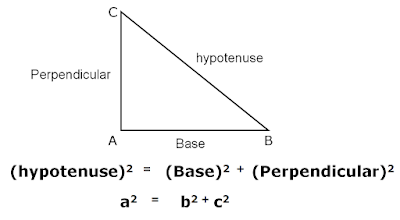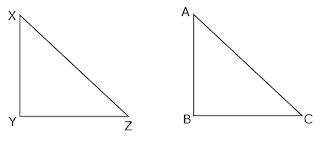Converse of Pythagorean Theorem – Word Problems
Converse of Pythagorean Theorem
In this section we are going to see the converse of Pythagorean theorem.
We know the Pythagorean theorem applies to right triangles and states that,
The square of the length of the hypotenuse, equals the sum of the squares of the lengths of the other two sides.
(hypotenuse)2 = (Base)2+(Perpendicular)2
a2 = b2 + c2
The Converse of Pythagorean Theorem states that,
In a triangle, if the square of the length of one side is equal to the sum of the squares of the other two sides, then the angle opposite to the first side is a right angle.
Given: A △ XYZ in which
XZ2 = XY2 + YZ2
To prove: ∠Y = 900
Construction: Draw a △ ABC, such that,
XY = AB, YZ = BC, and ∠B = 900

So, by Pythagoras theorem we get,
AC2 = XY2 + YZ2 …..(1)
(∵ XY = AB and YZ = BC)
But, XZ2 = XY2 + YZ2 ……(2) given
From (1) and (2) we get
XZ2 = AC2
∴ XZ = AC
Now in △ XYZ and △ ABC,
we get, XY = AB, YZ = BC, and XZ = AC
Therefore, △ XYZ ≅ △ ABC
Hence, ∠Y = ∠B = 900
∴ ∠Y = 900 Proved
Converse of Pythagorean Theorem -Word Problems
Example 1: Check whether a triangle with sides length are 3 cm, 5 cm, and 4 cm is a right triangle.
Solution:
We Check whether the square of the length of the longest side is the sum of the squares of the other two sides by the, converse of the Pythagorean theorem, the triangle is a right angle.

We know that the hypotenuse is the longest side in a triangle.
If 3 cm., 5 cm,. and 4 cm. are the length of sides of the triangle, and 5 cm, is the longest side of the triangle then 5 cm. will be the hypotenuse.
Apply the converse of Pythagorean theorem, the square of the length of the longest side is sum of the squares of the other two sides.
52 = 42 + 32
25 = 16 + 9
25 = 25
Since the square of the length of the longest side is the sum of the squares of the other two sides, by
the, converse of the Pythagorean theorem, the triangle is a right angle.
Example 2: Check whether a triangle with sides length 8 cm, 6 cm, and 10 cm is a right triangle.
Solution:
We Check whether the square of the length of the longest side is the sum of the squares of the other two sides by the, converse of the Pythagorean theorem, the triangle is a right angle.
We know that the hypotenuse is the longest side in a triangle.
If 3 cm., 5 cm,. and 4 cm. are the length of sides of the triangle, and 5 cm, is the longest side of the triangle then 5 cm. will be the hypotenuse.
Apply the converse of Pythagorean theorem, the square of the length of the longest side is sum of the squares of the other two sides.
102 = 82 + 62
100 = 64 + 36
100 = 100
Since the square of the length of the longest side is the sum of the squares of the other two sides.
by the, converse of the Pythagorean theorem, the triangle is a right angle.
In a triangle with side lengths are a, b, and c, where c is the length of the longest side,
if c2 < a2 + b2 then the triangle is an acute triangle and
if c2 > a2 + b2then the triangle is obtuse triangle.
Example 3: Check whether the triangle with side lengths are 5, 9, and 7 units is an acute, obtuse or right triangle.
Solution: The length of the longest side of the triangle is 9 units.
Other two sides of the triangle are 5 units and 7 units.
Now compare the square of the length of longest side and the sum of squares of the other two sides.
Square of the length of the longest side is 92 = 81 square units
Sum of squares of the other two sides is = 52 + 72
52 + 72 = 25 + 49
= 74 square units.
81 > 74
∴ 92 > 52 + 72
Therefore, the corollary to the the converse of the Pythagorean theorem, the triangle is an obtuse triangle.
Example 4. The length of sides of a triangle are 6 cm, 7.5 cm, and 4.5 cm. Is an acute, obtuse or right
triangle. If the triangle is right triangle, which side is the hypotenuse?
Solution: We know that in a right triangle the hypotenuse is the longest side. If 6 cm, 7.5 cm and 4.5 cm are the lengths of triangle, then 7.5 will be the hypotenuse.
Using the converse of Pythagorean theorem, we get
7.52 = 4.52 + 62
56.25 = 36 + 20.25
= 56.25
56.25 = 56.25
Since both sides are equal therefore, 6 cm, 7.5 cm, and 4.5 cm are the sides of the right angled triangle and hypotenuse will be the 7.5 cm.
Example 5. The lengths of sides of a triangle are 5 cm, 10 cm, and 15 cm. Is an an acute, obtuse or right triangle. If the triangle is right triangle, which side is the hypotenuse?
Solution: We know that in a right triangle the hypotenuse is the longest side. If 5 cm, 10 cm and 15 cm are the lengths of triangle, then 15 will be the hypotenuse.
Using the converse of Pythagorean theorem, we get
152 = 52 + 102
225 = 100 + 25
= 125
225 ≠ 125
225 > 125
∴ 152 > 52 + 102
Since both sides are not equal therefore, 5 cm, 10 cm, and 15 cm are not the sides of the right angled triangle.
Therefore, the corollary to the the converse of the Pythagorean theorem, the triangle is an obtuse triangle.
Example 6. The lengths of sides of a triangle are 8 cm, 15 cm, and 17 cm. Is an an acute, obtuse or right triangle. If the triangle is right triangle, which side is the hypotenuse?
Solution: We know that, in a right triangle the hypotenuse is the longest side. If 8 cm, 15 cm and 17 cm are the lengths of triangle, then 17 will be the hypotenuse.
Using the converse of Pythagoras theorem, we get,
172 = 152 + 82
289 = 64 + 225
289 = 289
Since both sides are equal therefore, 8 cm., 15 cm., and 17 cm. are the sides of the right angled triangle and hypotenuse will be the 17 cm.
Example 7. The lengths of sides of a triangle are 6 cm, 5 cm, and 11 cm. Is an an acute, obtuse or right
triangle. If the triangle is right triangle, which side is the hypotenuse?
Solution: We know that in a right triangle the hypotenuse is the longest side. If 6 cm, 5 cm and 11 cm are the lengths of triangle, then 11 will be the hypotenuse.
Using the converse of Pythagoras theorem theorem, we get,
112 = 52 + 62
121 = 36 + 25
= 61
121 ≠ 61
121 > 61
Since both sides are not equal therefore, 6 cm, 5 cm, and 11 cm are not the sides of the right angled triangle. The triangle is an obtuse triangle.
If the lengths of the sides of the triangle will be given in the questions then the above examples of the
converse of Pythagorean theorem will help us to determine the right triangle.
If the square of the length of the longest side is the sum of the squares of the other two sides by the,
converse of the Pythagorean theorem, the triangle is a right angle.
If the square of length of one side of a triangle is equal to the sum of the squares of the other two sides, then the angle opposite to the first side is a right angle.
of the length of one side of a triangle is equal to the sum of the squares of the other two sides, then the angle opposite to the first side is a right angle.
Example 8. The side of a triangle are of length 9 cm, 11 cm and 6 cm. Is this triangle a right triangle? If so, which side is the hypotenuse?
Solution: We know that hypotenuse is the longest side. If 9 cm, 11 cm and 6 cm are the lengths of angled triangle, then 11 cm will be the hypotenuse.
Using the converse of Pythagorean theorem, we get,
112 = 62 + 92
121 = 36 + 81
121 = 117
121 ≠ 117
121 > 117
Since both sides are not equal therefore, 11 cm, 6 cm, and 9 cm are not the sides of the right angled triangle. The triangle is an obtuse triangle.
Since, both the sides are not equal therefore 9 cm, 11 cm and 6 cm are not the side of the right angled
triangle.
The above examples of the converse of Pythagorean Theorem will help us to determine the right triangle when the sides of the triangles will be given in the questions.
If the square of the length of the longest side of a triangle is equal to the sum of the squares of the other two sides, then the triangle is a right triangle.
The length of one side of a triangle is equal to the sum of the squares of the other two sides, then the angle opposite to the first side is a right angle.